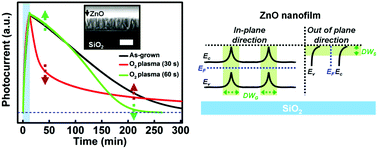Carrier transport behaviors depending on the two orthogonally directional energy bands in the ZnO nanofilm affected by oxygen plasma†
Abstract
An oxygen plasma treatment of ZnO nanostructures has frequently been used for obtaining a desired optoelectrical property. Nevertheless, a detailed study regarding carrier transport behaviors affected by the plasma has scarcely been managed, especially in the thin film structure, owing to its more complex physics than those of a one-dimensional nanostructure. Herein, we demonstrate an analysis of carrier transport behaviors on an oxygen plasma-treated ZnO nanofilm (50 nm thick) on a SiO2/Si substrate. By comparison with the as-grown sample, we observed drastic changes in carrier transport behavior according to the short exposure times of 30 s and 60 s. The plasma effect leading to the distinction was confirmed to originate from the bombardment of energetic ions near the surface and the diffusion of various oxygen ions and radicals into the host. The mechanism of the resulting carrier transport was comprehended through the revelation of two orthogonally directional energy band structures (surface band bending in the surface layer and localized energy bending at the grain boundary). Furthermore, we experimentally observed that the increased electrical barrier of the grain boundary, due to negatively absorbed oxygen ions, could be helpful in impeding persistent photoconductivity and in reducing dark current.


 Please wait while we load your content...
Please wait while we load your content...